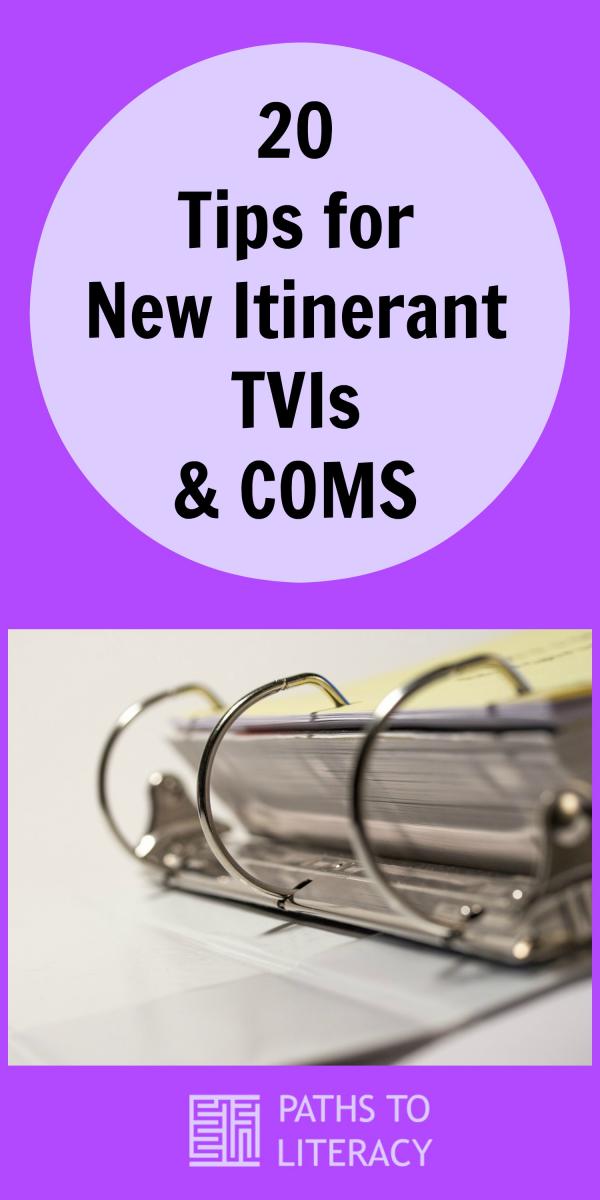 The start of a new school year brings a wide range of emotions: excitement about new beginnings, happiness in reconnecting with students and colleagues, and wistfulness at saying goodbye to the summer break. For new Teachers of the Visually Impaired (TVIs) and Certified Orientation and Mobility Specialists (COMS), there is also a layer of anxiety and uncertainty. You’ve completed your training, you’ve found a job, but now what? Getting organized and knowing how to get started are not typically covered in your professional training.
The start of a new school year brings a wide range of emotions: excitement about new beginnings, happiness in reconnecting with students and colleagues, and wistfulness at saying goodbye to the summer break. For new Teachers of the Visually Impaired (TVIs) and Certified Orientation and Mobility Specialists (COMS), there is also a layer of anxiety and uncertainty. You’ve completed your training, you’ve found a job, but now what? Getting organized and knowing how to get started are not typically covered in your professional training.
We’ve compiled some tips to help you get the school year off to a great start! We welcome ideas from the field about what else should be included on this list.
Getting Organized
- Go to each school a few days before the teachers come back to introduce yourself to administrators and people in the front office.
- Introducing yourself ahead of time is a great way to get the lay of the land before you start seeing students. It’s also very helpful to get to know some of the key people (secretary, IT, maintenance) before they are too busy with the demands of the new school year. Fostering those relationships can be extremely helpful!
- Create a system to keep track of all of the school calendars, school bell schedules, student schedules, and the names of teachers.
- Many people use Google Drive or Evernote to keep track of all of this. You can also print it all out and keep in a binder.
- Some itinerants recommend setting notifications to remind you where you need to be each day. No one wants to waste time by showing up at a school at the wrong time or on the wrong day!
- You may wish to begin by scheduling students who will receive direct services from you, and then build the rest of your schedule around that.
- Academic high school students may only have one period each day when they can be pulled for services, so it can be helpful to schedule them first.
- For elementary age students, check to be sure you know when recess and lunch are.
- Keep a list of related service providers (e.g. OT, PT, SLP).
- Introduce yourself to the teachers you’ll be working with and discuss expectations for the year.
- Many classroom teachers may be unclear about your role as a TVI or COMS, so it’s helpful to establish that at the beginning of the year. Discuss what type of direct instruction you plan to do (such as braille), what type of consultation or training you can do, and your role in helping to make the content accessible to the student (rather than teaching the actual content).
- Establish guidelines for how much time you or a braillist or paraprofessional will need to prepare materials.
- It may be helpful to establish a regular meeting time to check in.
- Keep a list of all of the equipment and materials you distribute with the date and location.
- It can be hard to keep track of all of this, so it’s important to have a system. What belongs to you? To an IMC (Instructional Materials Center) in your state or region? To the school district?
- Keep track of what needs repair, and what you have tried with whom.
- Introduce yourself to the families.
- Find out what their goals and expectations are for their child.
- Discuss any specific concerns they may have.
- Figure out a way to stay in touch on a regular basis. Some families may be comfortable in the digital world, and have no difficulty texting or emailing, while others may prefer some kind of a notebook or a phone call.
Getting Your Students Registered for Special Services and Materials
- Educate yourself about what resources are available to students with visual impairments. We have highlighted some of these below.
- Be sure that each of your students is registered for Federal Quota through APH (American Printing House for the Blind). The Federal Act to Promote the Education of the Blind was enacted by Congress in 1879. This Act set up a system to provide free textbooks and other hands-on instructional materials for students across the United States who are blind. Learn more about Federal Quota Funds.
- Register your students with NIMAC or the National Instructional Materials Center, which is a federally funded, online file repository of source files in the NIMAS format. Here, authorized users can access more than 52,000 K-12 NIMAS files for use in the production of accessible formats for students with disabilities.
- Register your students with Bookshare.
- Get free braille books for your students, if applicable.
Traveling
- Become familiar with the areas you will be going to. Since most itinerant teachers cover a lot of ground on a tight schedule, it’s helpful to know where you’re going, where to park, and how to find the classrooms or homes where you’ll be working.
- Create a system for keeping track of your mileage and follow whatever documentation process your school district uses.
- Be sure that your vehicle is in good shape, as you’ll be doing a lot of driving! Check your tires, oil, and perform regular maintenance, as recommended by the dealer. If you don’t drive, be sure that all transportation arrangements are in order.
Taking Care of Yourself
- Pack a lunch and healthy snacks, as well as a refillable water bottle.
- Be sure to have healthy snacks available in your car, as you will most likely be caught hungry and rushing to the next school on a regular basis. Some schools have refrigerators and/or microwaves that you may be able to use, and it’s helpful to make a note of this as you’re familiarizing yourself with new schools. A refillable water bottle is good for you and good for the environment!
- Get a collapsible cart to load all of your materials into.
- Your car is your office, so you’ll need to devise systems of bags, boxes or containers to stay organized. It can be especially helpful to find a way to be able to transport your materials into a school, so that you don’t strain your back.
- Identify people who can provide support to you in different kinds of ways.
- Being an itinerant teacher or COMS can be a difficult job! You may be working in relative isolation, and it can be a challenge to get the information or help you need. In addition to getting personal emotional support, try to find people who can provide information on various topics, such as early childhood, cortical visual impairment (CVI), Unified English Braille Code (UEB), deafblindness, assistive technology, transition, etc. It’s impossible to be an expert in everything, and even more of a challenge when you’re just starting out. Don’t be afraid to ask questions!
Documentation
- After a busy day of teaching, it can be hard to think about paperwork, so set up systems for yourself to make notes after each session with a student. Make a note of what you worked on, and any notes about performance or special concerns.
- It’s important to have a way to stay on top of evaluations and documentation. Set up a list of when the most recent Functional Vision Assessment, Learning Media Assessment, Low Vision Clinical Evaluation, Triennial Review, etc. has happened and when they should next be done.
- Set up a system for tracking progress on IEP goals for each student. TVI Liz Eagan has some great ideas for this: Check, Please? Guidelines for Documentation of Student Work and Data Sheets for Tracking IEP Goals.
- Have a look at other articles on this site by searching Back to School.
Additional Resources

Originally published August 2019




